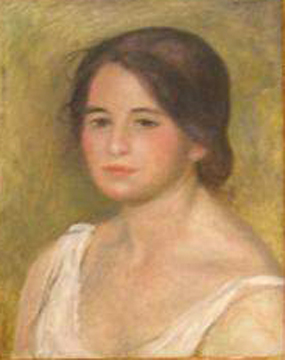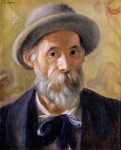
Pierre-Auguste Renoir
French, 1841-1919
Women in a White Chemise (Femme a la Chemise Blanche), 1900 ca.
oil on canvas
16 1/8 x 13 in.
SBMA, Gift of Dwight and Winifred Vedder
2006.54.10

Self-Portrait of Renoir, 1897
"A painting requires a little mystery, some vagueness, some fantasy. When you always make your meaning perfectly plain you end up boring people."
"To my mind, a picture should be something pleasant, cheerful, and pretty, yes pretty! There are too many unpleasant things in life as it is without creating still more of them."
"I want to paint stunning pictures that you can sell for very high prices."
- Pierre-Auguste Renoir
RESEARCH PAPER
I. The Artist
Pierre-Auguste Renoir was born in Limoges, France the son of a tailor and a dressmaker. The family moved to Paris when Renoir was a young child. At age 13 he was apprenticed to a porcelain painter where his talent was shown. After the failure of this business Renoir worked on painting blinds and fans. He continued to do "decorative" painting in homes and on other objects well into his career.
In his early twenties he studied in the studio of a painter named Gleyre where he learned about "classical" painting and drawing and received formal training at the Ecole des Beaux-Arts. There he met Monet, Bazille and other young artists who became friends and artistic companions. Monet and Renoir sometimes painted the same subjects together. Renoir also painted pictures of Monet and Bazille painting as well as portraits of Monet, his wife and one of Monet's wife and child in an outdoor setting as well as other artists, their families, mistresses and friends. He frequented the Louvre and copied works of well-known artists of the 18 th and early 19 th centuries. Among his artistic influences were 18 th century artists such as Watteau, Fragonard, and Boucher as well as those from the 19 th century including Courbet, Corot, Delacroix and Ingres.
In the 1860's some success came to Renoir when several of his paintings were accepted to be exhibited at the Salon, the arbiter of art in France. Over the years his submissions were both rejected and accepted by the Salon. One of the works accepted during the 1860s was a portrait of Alfred Sisley's father. Sisley was Renoir's good friend and fellow-painter. Another relatively early work accepted by the Salon was his portrait of Mme. Charpentier, her two children and her dog (Metropolitan Museum of Art). These works were somewhat traditional and therefore more acceptable than his later more impressionistic work. Renoir also exhibited at the Impressionists' own exhibitions beginning with the first one in 1874.
Renoir was part of various groups of artists, writers, composers, art dealers, intellectuals and others who met at different inns, restaurants and homes in and around Paris. The groups often included women artists as well as girlfriends of the men. These were times of increased intellectual, personal, political and artistic freedom.
Among his well-known paintings were scenes expressing the joy and freedom of these young people engaged in leisure social activities (e.g. Dancing at the Moulin Galette, Luncheon of the Boating Party ). Renoir used his friends and models in these and other paintings. Renoir had a few loyal patrons, collectors and dealers over different periods during his life who helped him.
Renoir lived with many friends and fellow artists during his early years, traveled extensively throughout Europe and to Algeria, where he created some of his outstanding works. He painted portraits, landscapes, cityscapes, and scenes depicting gatherings of individuals in various locations. Early on he was advised to paint in the outdoors (" en plein air") by one of the most famous Barbizon painters, Narcisse Diaz. He did so extensively. Early in his career (prior to the 1880s) most of his works he sold to dealers and to a small group of collectors for modest prices.
During the 1880s Renoir he became dissatisfied with what he felt was the formlessness of his Impressionist style and returned to a more traditional technique by defining contours more firmly and laying his paint in thin, smooth enamel-like layers. Some of his works showed a more "linear" style, smoother brushstrokes and a more subdued palette than previously. However, he did not abandon his impressionist style altogether.
As Renoir became more successful as an artist and with increasing age he settled in his own homes and married his mistress and model, Aline Charigot. They had three sons including Jean, who became a famous film maker and also wrote about his father. As he aged, Renoir developed severe arthritis, could not use his hands, and was confined to a wheelchair. However, he continued to paint using a brush strapped to his arm. Photographs show his hands totally curled, unable to move. Renoir continued to paint at a very high level almost to the time of his death in 1919 at the age of 78 at his home in Cagnes, France on the Mediterranean Coast
II. Portraiture
Portraits were a significant and large part of Renoir's total output. His financial success when it finally came was largely due to his portraits. His subjects were extremely varied, including children, families, nude women, well-dressed women, very young children, adolescents, rich, poor, friends, collectors, dealers, relatives of friends, dealers and collectors and groups of individuals. He used professional models, well-known individuals and working class women. Several of his models posed for Renoir over a period of several years, some of whom were his mistresses. He created portraits of himself during various stages of his life and did many of his family. Renoir was probably the best known figure painter among the impressionists. Portraits were largely realistic and sensitive, especially those of children and families. Comparisons of contemporary photographs of some of his subjects bear this out. Early his portraits were influenced by the popular photographs of individuals which were sold on cards.
Most of his portraits show the subject looking at the viewer but a few are in profile. Renoir was not always concerned with the setting and context as many show merely a colored background with no information about where the portrait was done. Still others were shown with only a vague depiction of the background with broad brush strokes indicating a nature setting. Occasionally the portrait would show a more definitive background either in indoor or outdoor settings. Several portraits showed strong influences from previous artists such as Velazquez, Delacroix and Rubens (voluptuous nudes). High quality portraits were painted until almost the end of his life.
III. "Femme a la Chemise Blanche"
This work was painted around 1900, relatively late in his career. The model is Gabrielle Renard, his wife's niece who lived with the Renoirs for about 20 years and was the nanny to his youngest child. (1) She was his favorite model for many years. Gabrielle also appeared in family portraits as well in the nude.
The young woman is looking at the viewer from a slight angle off center. There is no setting with a greenish-yellow background which matches the large, heavily decorated yellow-gold frame. The model has straight brown hair with the left side covering much of her forehead. The hair is done in a simple way. The face is oval shaped. Eyes are narrow and her expression does not give a strong indication of how she is feeling with the lip lines only slightly curved and the mouth closed. Brush strokes are flat and relatively even.
The upper part of her body above the breasts is shown, her checks and forehead have some red coloring and the upper body is painted with some dark strokes on the white skin, almost like a shadow. She is wearing a chemise, a slip with her shoulders, chest area and arms exposed. The left strap of the white chemise is shown down beyond the shoulder. Although much simpler, the garment is positioned on the woman similar to a portrait Renoir did earlier of the actress Jeanne Samary with the strap on her beautiful dress well over the left shoulder. White is often the color of garments in Renoir's portraits of women and children. This portrait is executed in a classical, sculptural form.
This portrait appears to show Renoir's continuing exploration of women showing them as nudes as well as in elaborate dress. We can think of this work as somewhat in between, a young woman in an undergarment.
At the end of his life, Renoir told his son Jean, "What is important is ...to avoid being literary and therefore to choose something that everyone knows--better still, to have no story at all...Under Louis XV, I would have been obliged to paint subjects. What seems to me the most important thing about our movement is that we have freed painting from the subject. I can paint flowers and simply call them 'flowers' without their having a story."
- Jean Renoir, Renoir: My Father , pp. 68, 179.
FOOTNOTE
Zafran, Eric M. Santa Barbara Collects: Impressions of France . Santa Barbara Museum of Art, Santa Barbara, CA, 1998 pp.104-105
Prepared for the SBMA Docent Council by Martin J. Molof April, 2007
BIBLIOGRAPHY
Bailey, Colin B. Renoir's Portraits . Catalog, National Gallery of Canada. Yale University Press, 1997.
McGraw- Hill Dictionary of Art. , McGraw Hill Publishing Co.,1969.
Monneret, Sophie (Translated by Emily Read). Renoir. Henry Holt and Company, 1989.
J. Turner(ed.). The Dictionary of Art . Vol. 26. MacMillan and Co., 1996
